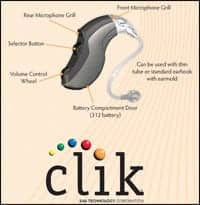The Clik digital hearing instrument is the first digital hearing aid that can be fit without cables or computers. Its unique programming also allows patients to actively sample and “lock in” on preferred algorithms.
The principle driving every product launch by Ear Technology Corporation has been “Innovation with a purpose: Helping people hear better everyday.” This principle was behind the introduction of Dry & Store® in 1997, TransEar® in 2005, and, most recently, Clik®.

|
| Daniel R. Schumaier, PhD |
Clik is the first digital hearing aid that hearing care providers program and fit without cables or computers. Daniel R. Schumaier, PhD, the inventor of Clik and a dispensing audiologist himself, came up with the idea of Clik because of his own frustration with computer systems that seem to crash at the most inconvenient times.
“When your computer is down, you’re out of business,” says Dr Schumaier. “You can’t fit hearing aids.” While the industry has shifted to digital processing for good reasons, such as better sound quality and more programming options, the downside is that it has increased dependence on specialized computer software and interfaces such as NOAHlink and Hi-Pro boxes, as well as software that is proprietary to each brand, and a seemingly endless supply of cables—all different.
Advanced Features Made Easy
Ear Technology takes the approach that, even though the technology underlying a digital hearing aid is complex, the provider interface with that technology doesn’t have to be. Clik is not a wireless device or a wireless programming interface. Rather, a variety of acoustic algorithms are preloaded onto the microchip in Clik’s processor. You access each algorithm by “click’ing” through sound-coded options using a selector button on the BTE processor.
Called ClikFit™ programming, it effectively changes the way professionals interface with the hearing aid. It takes computers, software, and cables off of the desktop and loads them onto the processor. Providers can apply acoustic parameters for their patients based on patient audiograms, real-ear measurement, patient feedback, or any combination of these methodologies.

The Power of Empowerment
Empowering the end user. With Clik, you now have more options on what approach to take in the fitting process. You can completely configure the hearing aid in-office for both Quiet and Noise. Or, after configuring the aid for Quiet, you can coach a tech-savvy patient on how to sample the different algorithms in his or her own real-life noisy situations, and then “lock in” the setting that he or she likes best. This can be particularly helpful when the hearing loss is easy to fit but the patient is hard to please.
We call this the “power of empowerment,” referring to multiple studies in the medical field, which show that patient involvement increases positive outcomes with products and services provided. There’s also growing recognition that many factors, such as personal attention, counseling, and follow-up, contribute to patient satisfaction and acceptance of hearing aids.
In other words, fittings that are purely “by the numbers” without patient input to the specific amplification settings or attention to relationship-building are less likely to succeed. This should come as no surprise when we take time to reflect on our own experiences as patients or even as consumers. Who among us likes to be treated as a number, whether it’s for personal medical needs or routine daily activities, such as calling a business or making a purchase at a store?
Empowering the professional. Because you’re no longer tethered to the computer, you’ll get to know your patients, not just their audiograms. The actual fitting protocol is easy to use and can significantly improve your efficiency in mild-to-moderate loss fittings; additionally, you gain more time for learning about your patient’s lifestyle, for patient counseling, and for addressing more challenging hearing conditions.
A patient-centered environment doesn’t mean the abandonment of advanced technology. With Clik, it’s quite the opposite, actually marrying the two—at an exceptional price and without compromising quality.
Clik is fully equipped with features that would be either considered “extras” or not even available on many of today’s small BTEs, such as directional microphones, twin telecoils, digital volume control, adaptive feedback cancellation, and layered noise reduction technology.
The hearing instrument also has an advanced programming mode that is strictly for professional use only. Here you can read out program selections, activate or deactivate specific functions, change the MPO, or completely reset the instrument. It is presently available as a mini-BTE using either a slim tube/tip configuration or standard earhook with custom earmold to increase gain. Development is under way for other applications of the ClikFit technology, including an ITE version.
For our profession. Clik is not an over-the-counter Internet or mail-order hearing aid; it is available only through licensed hearing care professionals, with fitting and sales accomplished through face-to-face consultation between end-users and providers.
For more information, call (888) 382-9327, e-mail , or visit www.clik-hearing.com.
This article was submitted to HR by Kathryn (Katy) Pindzola, director of marketing and operations at Ear Technology Corporation, Johnson City, Tenn. Correspondence can be addressed to HR or .
Citation for this article:
Pindzola K. Clik: An easy-to-fit and elegant hearing solution. Hearing Review. 2010;17(4)[Suppl]:6.





